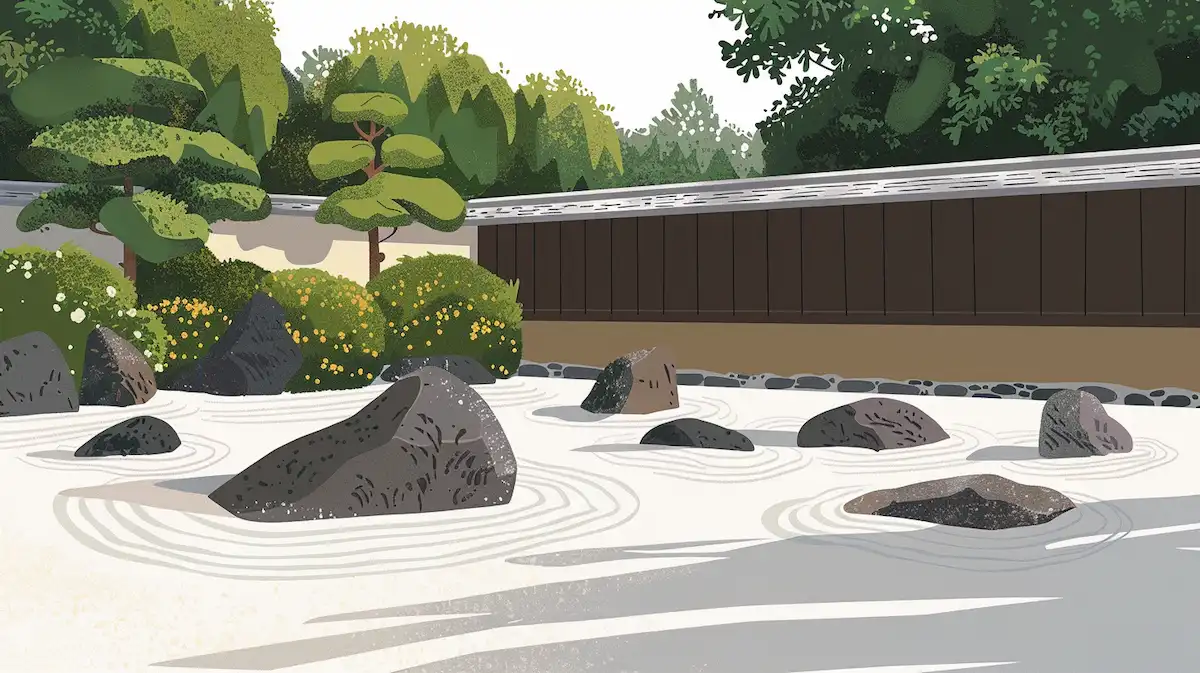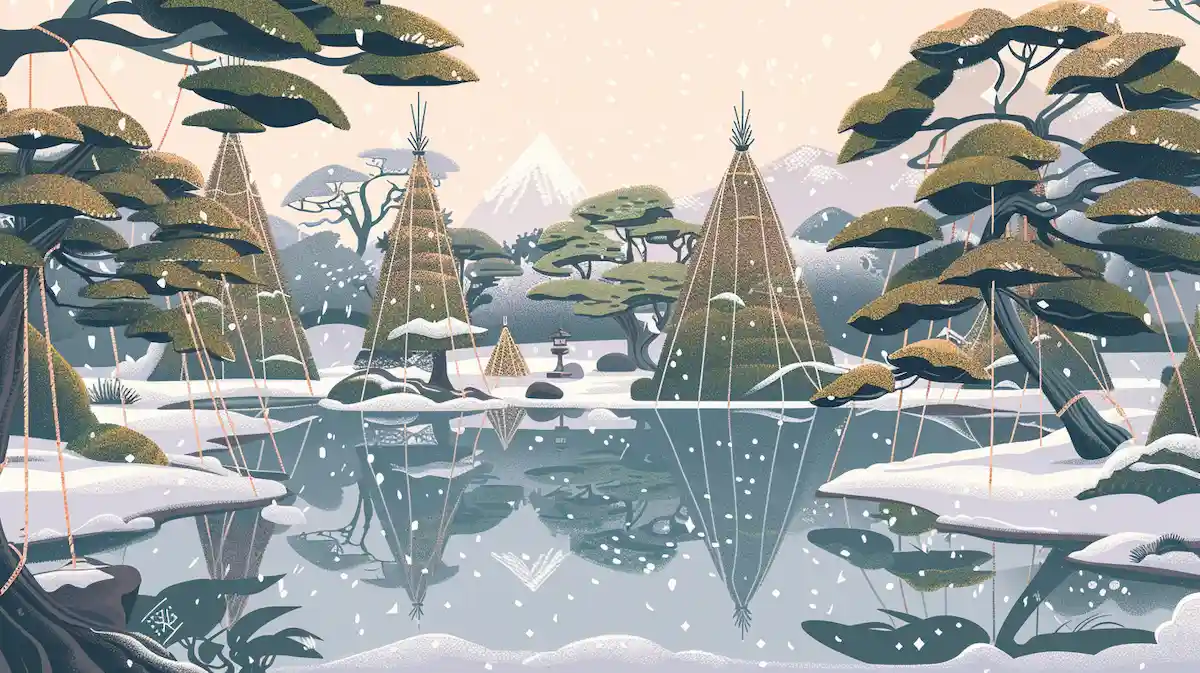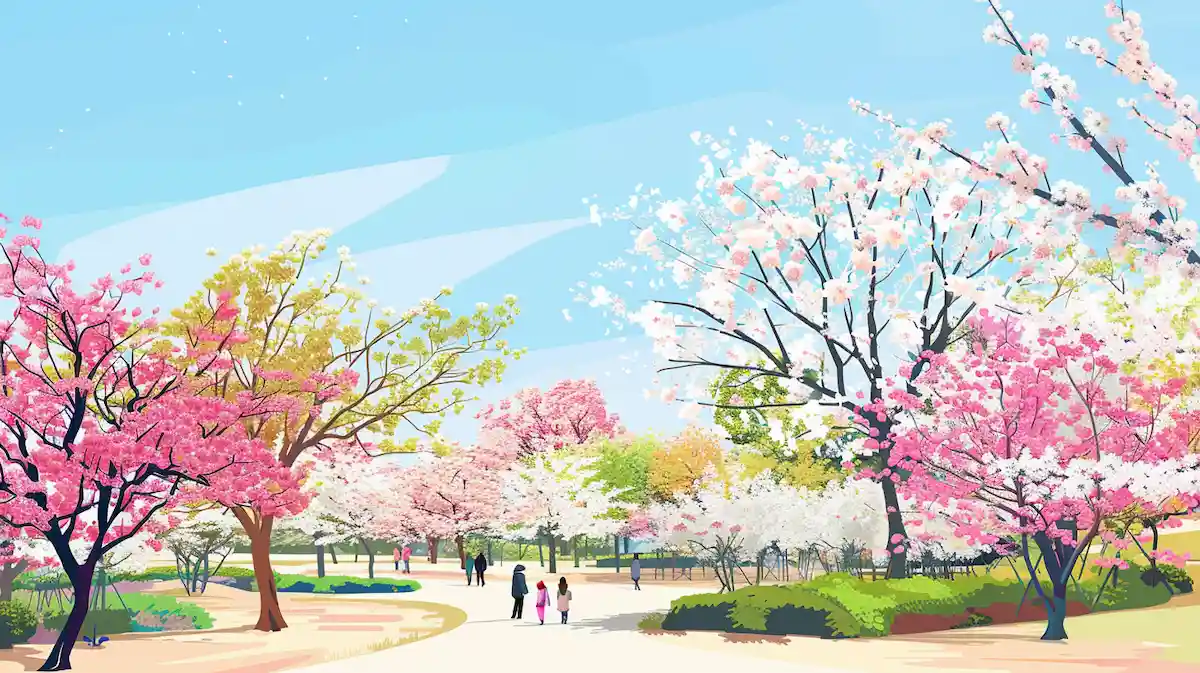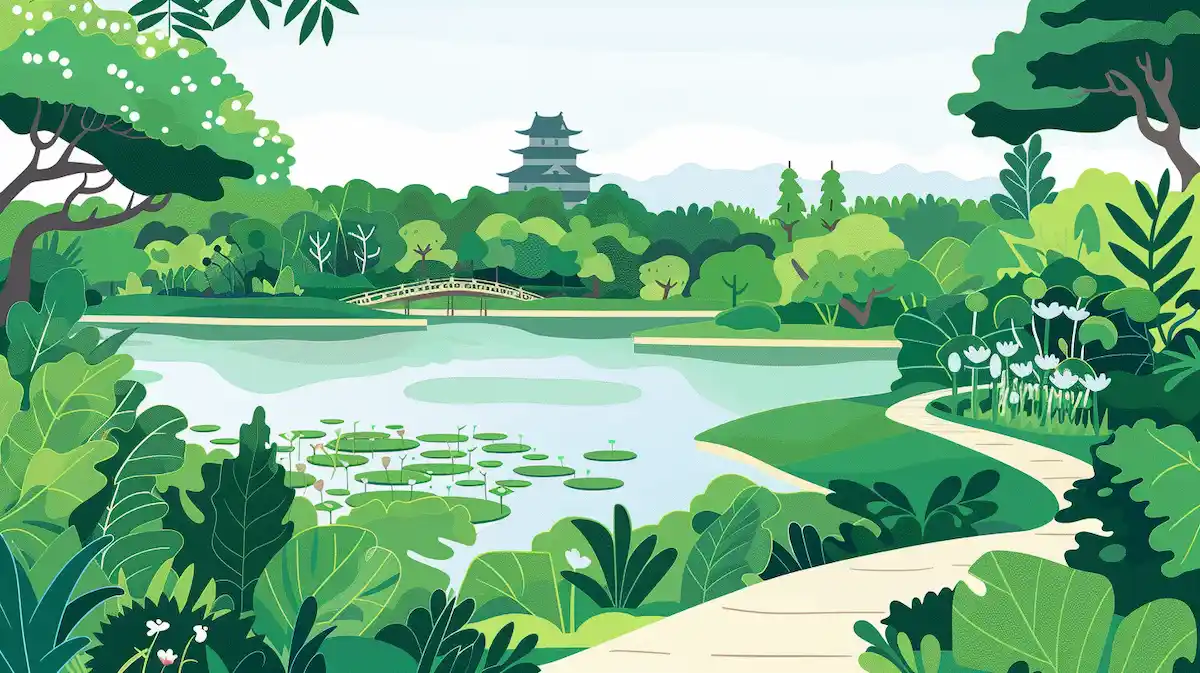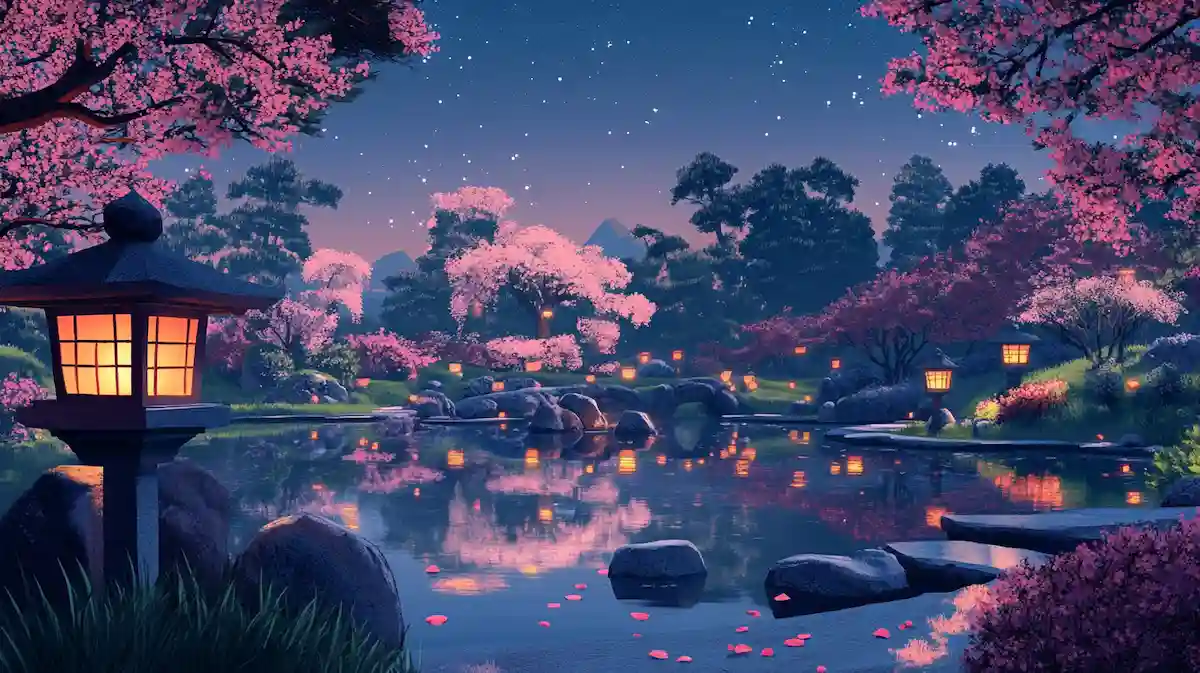日本庭園を英語で説明・紹介するための基本情報と、英会話に役立つ表現をシンプルでわかりやすい英語で紹介します。
英会話ダイアローグ・関連情報・10の質問を通して、日本庭園に関する英語表現を学びます。
英語
英会話ダイアローグを読む前に知っておくと良い前提知識と情報です。
- 日本庭園の基本的な知識
- 自然の再現: 自然の風景を再現し、人工的に見えないように配置を工夫
- 調和と静けさ: 庭園のデザインは、自然との調和と、静かで落ち着いた雰囲気を重視
- 四季の変化: 日本庭園は四季の移ろいを楽しめるように設計、桜、紅葉、雪景色など、季節ごとに異なる美しさを感じられる
- 日本庭園の種類
- 日本庭園の代表的な例
- 日本庭園の魅力
- 精神的な癒し: 静けさと調和のある空間が、訪れる人に安らぎを与える
- 四季ごとの変化: 四季の移ろいを通じて、訪れるたびに異なる美しさを体験できる
- 文化的価値: 日本庭園には歴史や日本独自の美意識が詰まっており、日本文化の深さを感じられる
2人が日本庭園について話しています。
日本庭園の美しさや特徴、歴史、枯山水や池泉回遊式庭園、茶庭といった庭園の種類や四季折々の変化などを話題にしています。
会話 / dialogue

Key, I’ve really been interested in Japanese gardens lately. They seem so peaceful, and I’d love to understand them better. Do you know much about them?

Oh, Japanese gardens are beautiful and have a deep history. They’re designed to recreate natural landscapes in a small space. Have you visited any yet?

Not yet, but I’d like to! I’ve heard they use rocks, sand, water, and plants in such a balanced way. It’s fascinating how they aim to look natural but are so carefully planned.

Exactly. One of the main types is the Karesansui, or dry landscape garden. You’ll often see this style in Zen temples, like Ryoan-ji in Kyoto. They use rocks and sand to represent mountains, rivers, and even oceans, without any water.

So, it’s all about symbolism? I like the idea of finding meaning in simple things. I think seeing a garden like that could be really calming.

Yes, it’s very calming! There’s also the Pond Strolling Garden. These gardens have a large pond in the center, with paths around it so you can enjoy different views. Kenroku-en in Kanazawa and Koraku-en in Okayama are famous examples.

Oh, I’ve heard of Kenroku-en! I didn’t realize it was a strolling garden. So, you can walk around and see the garden from many angles?

Exactly. It’s designed for that. You’ll find small bridges and islands in the pond, and even koi fish. The view changes as you walk, which makes it great for exploring.

That sounds amazing. I’d love to visit in the spring when the cherry blossoms are blooming. I heard Japanese gardens are beautiful in all seasons, though.

That’s true. Japanese gardens are designed to highlight each season—cherry blossoms in spring, lush green leaves in summer, red and yellow leaves in autumn, and sometimes snow in winter. The changing views make each season special.

I love that connection to the seasons. It must feel different every time you visit. Are there other garden types?

Yes, there’s also the Tea Garden, which leads to a tea house. The path, called the “roji,” has stepping stones and a water basin to wash your hands before entering the tea room. It’s all about preparing the mind and spirit for the tea ceremony.

That sounds so peaceful. The whole process seems thoughtful. Are there famous tea gardens in Japan?

Many! Kyoto has some beautiful ones, like at Katsura Imperial Villa. It’s a classic example with a tea house, garden paths, and scenic views.

So, each type of garden has a different purpose. I’d love to experience them all—Karesansui, strolling gardens, and tea gardens. They seem to reflect Japanese ideas about nature and life.

Absolutely. Japanese gardens are like small worlds that capture harmony and balance. They bring out the beauty of natural elements like water, stones, and plants in every detail.

I think I’d really enjoy just walking around one. I’ve also read about Ryoan-ji’s rock garden. It seems so simple but has a deep meaning.

Yes, Ryoan-ji’s rock garden is famous for its simplicity and quiet beauty. It’s just white sand and 15 rocks, but the arrangement creates a sense of calm and invites reflection.

That sounds perfect. I’d like to try and feel that same calmness. Maybe it’s something you can only understand by experiencing it in person.

I think so. Japanese gardens aren’t just about looks—they’re a way to connect with nature. Visiting one can feel like stepping into a different, more peaceful world.

I’ll definitely start visiting some gardens. They seem to offer more than just scenery; it’s like they bring together history, nature, and Japanese culture.

Yes, they do. Visiting a Japanese garden can be a rich experience. You’ll see the cultural value in each element and feel a sense of peace that’s unique to these gardens.

Thanks for sharing, Key. I’m excited to explore these gardens now, and I feel like I’ll have a deeper understanding of their beauty.
関連情報 / related information
「日本庭園」について、理解を深めるための「英語での関連情報」です。
日本庭園

What is a Japanese Garden?
A Japanese garden is a traditional style of garden that reflects Japanese ideas about nature, beauty, and harmony. It’s designed to look like a natural landscape, with features like rocks, water, plants, and sometimes sand. Each part of the garden is carefully arranged to create balance and peace.
Types of Japanese Gardens
There are different types of Japanese gardens. Karesansui, or dry landscape gardens, use rocks and sand to represent mountains and rivers. They are often found in Zen temples and encourage quiet reflection. Pond Strolling Gardens have a large pond in the center, with pathways around it for walking and enjoying different views. Tea Gardens are designed for the tea ceremony and have stepping stones, a water basin, and a path leading to a tea house.
Seasonal Beauty
Japanese gardens are made to show the beauty of each season. In spring, cherry blossoms bloom; in summer, trees are lush and green; in autumn, leaves turn bright red and yellow; and in winter, snow may cover the garden. These seasonal changes make each visit to the garden feel unique.
The Charm of Japanese Gardens
Japanese gardens are special places for relaxing and enjoying nature. They combine art, nature, and Japanese culture, creating a peaceful space that many people find calming and beautiful.
10の質問 / 10 questions
「日本庭園」について、理解を深めるための「英語での10の質問」です。
1: What is a Japanese garden?
A Japanese garden is a traditional garden style in Japan that represents nature, beauty, and harmony. It often uses rocks, water, sand, and plants to recreate natural landscapes.
2: What is the purpose of a Japanese garden?
Japanese gardens are designed to create a peaceful, balanced space where people can feel connected to nature. They are also places to relax and reflect.
3: What is karesansui, or a dry landscape garden?
Karesansui, or dry landscape gardens, use rocks and sand to represent mountains and rivers. They are often found in Zen temples and help encourage calm and quiet reflection.
4: What is a pond strolling garden?
A pond strolling garden has a large pond in the center and paths around it. Visitors can walk along these paths to enjoy different views of the garden, with bridges and small islands in the pond.
5: What is a tea garden?
A tea garden, or roji, is a garden that leads to a tea house. It has stepping stones, a water basin, and plants to create a simple, natural setting for the tea ceremony.
6: How do Japanese gardens reflect the seasons?
Japanese gardens include seasonal plants like cherry trees, maple trees, and pines. These plants change with each season, allowing visitors to enjoy cherry blossoms in spring, green trees in summer, colorful leaves in autumn, and snow in winter.
7: What materials are commonly used in Japanese gardens?
Japanese gardens often use rocks, sand, water, and plants. These materials are carefully arranged to recreate natural landscapes and create a sense of harmony.
8: Why are Japanese gardens often found in temples?
Japanese gardens are common in temples because they create a calm, peaceful space ideal for meditation and reflection, aligning with Buddhist and Zen principles.
9: What is unique about the garden at Ryoan-ji Temple?
The garden at Ryoan-ji Temple is a famous example of karesansui. It uses only white sand and 15 rocks, arranged to inspire calm and reflection in a very simple design.
10: What makes Japanese gardens popular with tourists?
Japanese gardens are popular with tourists because they showcase Japanese culture, art, and respect for nature. They offer a peaceful, beautiful experience and highlight the seasonal beauty of Japan.
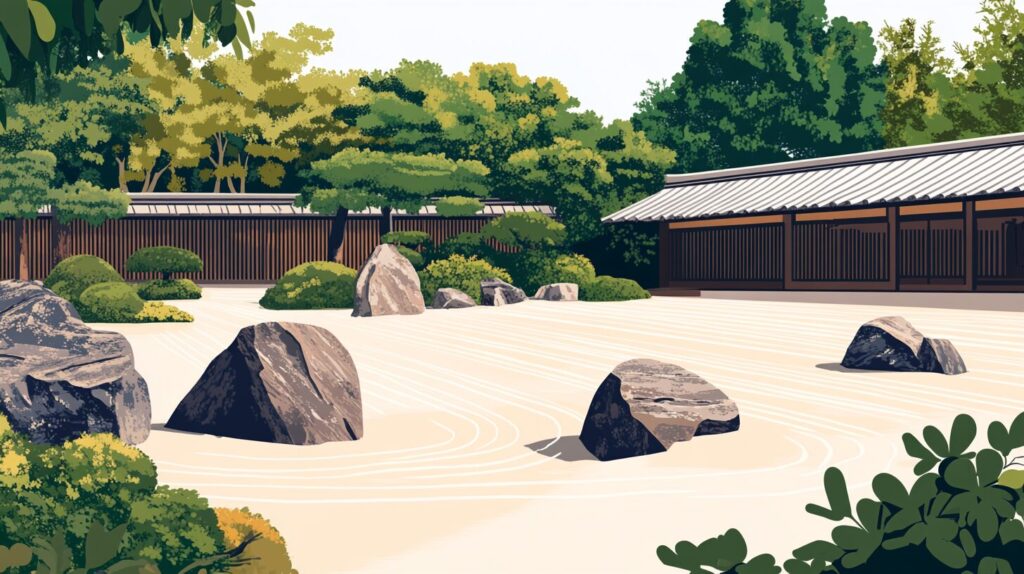
和訳付
会話 / dialogue

Key, I’ve really been interested in Japanese gardens lately. They seem so peaceful, and I’d love to understand them better. Do you know much about them?
キー、日本庭園にすごく興味が出てきたんだ。すごく穏やかな感じがするし、もっとよく知りたいんだ。詳しく知ってる?

Oh, Japanese gardens are beautiful and have a deep history. They’re designed to recreate natural landscapes in a small space. Have you visited any yet?
ああ、日本庭園は美しいし、深い歴史があるよ。小さなスペースに自然の風景を再現するように作られているんだ。もう行ったことある?

Not yet, but I’d like to! I’ve heard they use rocks, sand, water, and plants in such a balanced way. It’s fascinating how they aim to look natural but are so carefully planned.
まだなんだ。でも行きたいな!岩や砂、水や植物がバランスよく使われているって聞いたよ。本物の自然みたいだけど、実はすごく計画的に作られてるのが面白いよね。

Exactly. One of the main types is the Karesansui, or dry landscape garden. You’ll often see this style in Zen temples, like Ryoan-ji in Kyoto. They use rocks and sand to represent mountains, rivers, and even oceans, without any water.
その通り。代表的なスタイルの一つが枯山水で、京都の龍安寺みたいな禅寺に多いんだ。水を使わずに岩や砂で山や川、海を表現しているんだよ。

So, it’s all about symbolism? I like the idea of finding meaning in simple things. I think seeing a garden like that could be really calming.
じゃあ、シンボル的な意味があるんだね?シンプルなものに意味を見つけるっていう考えがいいね。そんな庭を見たら、すごく落ち着きそう。

Yes, it’s very calming! There’s also the Pond Strolling Garden. These gardens have a large pond in the center, with paths around it so you can enjoy different views. Kenroku-en in Kanazawa and Koraku-en in Okayama are famous examples.
そう、すごく落ち着くよ!あと、池泉回遊式庭園っていうスタイルもあるんだ。大きな池が中心にあって、その周りを歩いてさまざまな景色を楽しめるんだ。金沢の兼六園や岡山の後楽園が有名な例だね。

Oh, I’ve heard of Kenroku-en! I didn’t realize it was a strolling garden. So, you can walk around and see the garden from many angles?
あ、兼六園って聞いたことあるよ!回遊式庭園だったんだね。じゃあ、歩きながらいろんな角度から庭が見られるんだ?

Exactly. It’s designed for that. You’ll find small bridges and islands in the pond, and even koi fish. The view changes as you walk, which makes it great for exploring.
そうだよ。まさにそのために作られているんだ。池には小さな橋や島があって、鯉も泳いでいるよ。歩くたびに景色が変わるから、探検するのにぴったりだよ。

That sounds amazing. I’d love to visit in the spring when the cherry blossoms are blooming. I heard Japanese gardens are beautiful in all seasons, though.
素晴らしいね。桜が咲く春に行ってみたいな。でも、日本庭園はどの季節も美しいって聞いたよ。

That’s true. Japanese gardens are designed to highlight each season—cherry blossoms in spring, lush green leaves in summer, red and yellow leaves in autumn, and sometimes snow in winter. The changing views make each season special.
その通り。日本庭園は四季の美しさを際立たせるように作られているんだ。春は桜、夏は緑、秋は紅葉、冬は雪景色と、季節ごとに異なる景色が楽しめるよ。

I love that connection to the seasons. It must feel different every time you visit. Are there other garden types?
季節とのつながりがいいね。行くたびに違った感じがするんだろうね。他にも種類があるの?

Yes, there’s also the Tea Garden, which leads to a tea house. The path, called the “roji,” has stepping stones and a water basin to wash your hands before entering the tea room. It’s all about preparing the mind and spirit for the tea ceremony.
うん、茶庭もあるよ。茶室へ続く庭で、『露地』と呼ばれる道には飛び石や手を清めるための手水鉢があるんだ。茶道に向けて心を整えるためのものなんだ。

That sounds so peaceful. The whole process seems thoughtful. Are there famous tea gardens in Japan?
すごく穏やかな感じだね。すべてが考えられてる感じがするよ。日本には有名な茶庭もあるの?

Many! Kyoto has some beautiful ones, like at Katsura Imperial Villa. It’s a classic example with a tea house, garden paths, and scenic views.
たくさんあるよ!京都には桂離宮みたいに美しい茶庭があるんだ。茶室や庭園の小道、素晴らしい景色が楽しめるよ。

So, each type of garden has a different purpose. I’d love to experience them all—Karesansui, strolling gardens, and tea gardens. They seem to reflect Japanese ideas about nature and life.
つまり、庭の種類ごとに異なる目的があるんだね。枯山水や回遊式庭園、茶庭、全部体験してみたいな。日本の自然や人生観が反映されている気がするよ。

Absolutely. Japanese gardens are like small worlds that capture harmony and balance. They bring out the beauty of natural elements like water, stones, and plants in every detail.
まさにその通り。日本庭園は小さな世界のようで、調和とバランスが詰まっているんだ。水や石、植物などの自然の美しさが細部にまで表現されているよ。

I think I’d really enjoy just walking around one. I’ve also read about Ryoan-ji’s rock garden. It seems so simple but has a deep meaning.
きっと歩き回るだけでも楽しめそうだね。龍安寺の石庭についても読んだことがあるよ。シンプルだけど深い意味があるらしいね。

Yes, Ryoan-ji’s rock garden is famous for its simplicity and quiet beauty. It’s just white sand and 15 rocks, but the arrangement creates a sense of calm and invites reflection.
そう、龍安寺の石庭はそのシンプルさと静かな美しさで有名なんだ。白砂と15個の石だけなんだけど、その配置が心の落ち着きを生み、考えを深めるんだ。

That sounds perfect. I’d like to try and feel that same calmness. Maybe it’s something you can only understand by experiencing it in person.
それは完璧だね。その落ち着きを自分でも感じてみたいな。実際に体験してこそ分かるものかもしれないね。

I think so. Japanese gardens aren’t just about looks—they’re a way to connect with nature. Visiting one can feel like stepping into a different, more peaceful world.
たぶんそうだね。日本庭園は見た目だけじゃなくて、自然とつながるための場所なんだ。訪れることで、違う、もっと穏やかな世界に入るような気持ちになれるよ。

I’ll definitely start visiting some gardens. They seem to offer more than just scenery; it’s like they bring together history, nature, and Japanese culture.
絶対にいくつかの庭園を訪れてみるよ。単なる風景以上のものを提供しているようだし、歴史や自然、日本の文化が一体になっている感じがするよ。

Yes, they do. Visiting a Japanese garden can be a rich experience. You’ll see the cultural value in each element and feel a sense of peace that’s unique to these gardens.
そうだね。日本庭園を訪れるのはとても豊かな体験になるよ。庭園の各要素に込められた文化的な価値を感じられるし、日本庭園ならではの平和な感覚も味わえるんだ。

Thanks for sharing, Key. I’m excited to explore these gardens now, and I feel like I’ll have a deeper understanding of their beauty.
話してくれてありがとう、キー。今、日本庭園を探索するのが楽しみだし、その美しさをもっと深く理解できそうな気がするよ。
関連情報 / related information
日本庭園

What is a Japanese Garden?
A Japanese garden is a traditional style of garden that reflects Japanese ideas about nature, beauty, and harmony. It’s designed to look like a natural landscape, with features like rocks, water, plants, and sometimes sand. Each part of the garden is carefully arranged to create balance and peace.
日本庭園は、自然、美しさ、調和に関する日本の考え方を反映した伝統的な庭園のスタイルです。岩、水、植物、時には砂などを使い、自然の風景のように見えるように作られています。庭の各部分は、バランスと平和を生むように丁寧に配置されています。
Types of Japanese Gardens
There are different types of Japanese gardens. Karesansui, or dry landscape gardens, use rocks and sand to represent mountains and rivers. They are often found in Zen temples and encourage quiet reflection. Pond Strolling Gardens have a large pond in the center, with pathways around it for walking and enjoying different views. Tea Gardens are designed for the tea ceremony and have stepping stones, a water basin, and a path leading to a tea house.
日本庭園にはさまざまな種類があります。枯山水(かれさんすい)は、岩と砂で山や川を表現する庭で、禅寺によく見られ、静かな瞑想を促します。池泉回遊式庭園は中心に大きな池があり、周りに歩道が設けられているので、歩きながら異なる景色を楽しむことができます。茶庭は茶道のための庭で、飛び石や手水鉢、茶室へ続く道が特徴です。
Seasonal Beauty
Japanese gardens are made to show the beauty of each season. In spring, cherry blossoms bloom; in summer, trees are lush and green; in autumn, leaves turn bright red and yellow; and in winter, snow may cover the garden. These seasonal changes make each visit to the garden feel unique.
日本庭園は、四季折々の美しさを表現するように作られています。春には桜が咲き、夏には木々が青々と茂り、秋には葉が赤や黄色に色づき、冬には雪が庭を覆うこともあります。こうした季節の変化によって、訪れるたびに新しい美しさを感じることができます。
The Charm of Japanese Gardens
Japanese gardens are special places for relaxing and enjoying nature. They combine art, nature, and Japanese culture, creating a peaceful space that many people find calming and beautiful.
日本庭園は、リラックスして自然を楽しむための特別な場所です。芸術、自然、日本文化が一体となり、穏やかで美しい空間を作り出しています。訪れる人にとって、心を落ち着かせる場所として、多くの魅力を持っています。
10の質問 / 10 questions
1: What is a Japanese garden?
日本庭園とは何ですか?
A Japanese garden is a traditional garden style in Japan that represents nature, beauty, and harmony. It often uses rocks, water, sand, and plants to recreate natural landscapes.
日本庭園は、日本の伝統的な庭園スタイルで、自然、美しさ、調和を表現しています。岩、水、砂、植物を使って自然の風景を再現することが多いです。
2: What is the purpose of a Japanese garden?
日本庭園の目的は何ですか?
Japanese gardens are designed to create a peaceful, balanced space where people can feel connected to nature. They are also places to relax and reflect.
日本庭園は、人々が自然とつながり、穏やかでバランスの取れた空間を作ることを目的としています。また、リラックスや内省の場所でもあります。
3: What is karesansui, or a dry landscape garden?
枯山水とは何ですか?
Karesansui, or dry landscape gardens, use rocks and sand to represent mountains and rivers. They are often found in Zen temples and help encourage calm and quiet reflection.
枯山水は、岩と砂で山や川を表現する庭園で、禅寺に多く見られます。心を落ち着かせ、静かな瞑想を促す役割があります。
4: What is a pond strolling garden?
池泉回遊式庭園とは何ですか?
A pond strolling garden has a large pond in the center and paths around it. Visitors can walk along these paths to enjoy different views of the garden, with bridges and small islands in the pond.
池泉回遊式庭園は、中心に大きな池があり、その周りに歩道がある庭園です。訪れる人はその歩道を歩きながら、池にかかる橋や小島など、さまざまな景色を楽しむことができます。
5: What is a tea garden?
茶庭とは何ですか?
A tea garden, or roji, is a garden that leads to a tea house. It has stepping stones, a water basin, and plants to create a simple, natural setting for the tea ceremony.
茶庭(または露地)は、茶室へと続く庭で、飛び石や手水鉢、植物があり、茶道のためのシンプルで自然な空間を作っています。
6: How do Japanese gardens reflect the seasons?
日本庭園はどのように四季を反映していますか?
Japanese gardens include seasonal plants like cherry trees, maple trees, and pines. These plants change with each season, allowing visitors to enjoy cherry blossoms in spring, green trees in summer, colorful leaves in autumn, and snow in winter.
日本庭園には、桜、カエデ、松などの季節ごとの植物が植えられています。これらの植物が四季折々に変化し、春には桜、夏には青々とした木々、秋には紅葉、冬には雪景色が楽しめます。
7: What materials are commonly used in Japanese gardens?
日本庭園で一般的に使われる素材は何ですか?
Japanese gardens often use rocks, sand, water, and plants. These materials are carefully arranged to recreate natural landscapes and create a sense of harmony.
日本庭園では、岩、砂、水、植物がよく使われます。これらの素材は自然の風景を再現し、調和を生み出すように丁寧に配置されています。
8: Why are Japanese gardens often found in temples?
なぜ日本庭園は寺院によく見られるのでしょうか?
Japanese gardens are common in temples because they create a calm, peaceful space ideal for meditation and reflection, aligning with Buddhist and Zen principles.
日本庭園は、瞑想や内省に適した穏やかで静かな空間を作り、仏教や禅の教えと調和しているため、寺院でよく見られます。
9: What is unique about the garden at Ryoan-ji Temple?
龍安寺の庭園にはどんな特徴がありますか?
The garden at Ryoan-ji Temple is a famous example of karesansui. It uses only white sand and 15 rocks, arranged to inspire calm and reflection in a very simple design.
龍安寺の庭園は枯山水の代表例で、白砂と15個の岩だけを使い、非常にシンプルなデザインで心の落ち着きと内省を促すように作られています。
10: What makes Japanese gardens popular with tourists?
日本庭園が観光客に人気の理由は何ですか?
Japanese gardens are popular with tourists because they showcase Japanese culture, art, and respect for nature. They offer a peaceful, beautiful experience and highlight the seasonal beauty of Japan.
日本庭園は、日本の文化や芸術、自然への敬意を示しており、穏やかで美しい体験を提供するため観光客に人気があります。また、日本の四季の美しさも楽しめます。

words & phrases
英会話ダイアローグと関連情報に出てきた単語・フレーズです(例文は各3つ)。

represent : 動詞
意味: 表す、象徴する。To stand for or symbolize something.
(日本庭園の石や砂が山や川を象徴することを指す)
例文:
- The rocks in the garden represent mountains and rivers.
「庭園の岩は山や川を表しています。」 - Red roses often represent love and passion.
「赤いバラはよく愛と情熱を象徴します。」 - This flag represents our country’s identity.
「この旗は私たちの国のアイデンティティを表しています。」
lush : 形容詞
意味: 緑豊かな、青々とした。Richly green and full, often referring to plants and vegetation.
(日本庭園の夏の青々とした木々を指す)
例文:
- The garden was filled with lush green trees.
「庭園は青々とした木々でいっぱいでした。」 - The rain made the forest look even more lush.
「雨で森がさらに青々と見えました。」 - They walked through the lush countryside.
「彼らは緑豊かな田舎を歩きました。」
thoughtful : 形容詞
意味: 思慮深い、よく考えられた。Showing careful consideration or concern.
(茶庭のデザインが考え抜かれたものとして説明)
例文:
- The garden’s design is very thoughtful and peaceful.
「庭のデザインはとても考え抜かれていて、穏やかです。」 - She gave me a thoughtful gift on my birthday.
「彼女は私の誕生日に思いやりのある贈り物をくれました。」 - His thoughtful advice helped me a lot.
「彼の思慮深いアドバイスがとても助けになりました。」
combine : 動詞
意味: 組み合わせる、結合する。To bring two or more things together.
(日本庭園が自然、芸術、日本文化を結びつけていることを指す)
例文:
- Japanese gardens combine art, nature, and culture.
「日本庭園は芸術、自然、文化を組み合わせています。」 - They combined their skills to complete the project.
「彼らはスキルを組み合わせてプロジェクトを完成させました。」 - Let’s combine our ideas for the presentation.
「プレゼンのためにアイデアを組み合わせましょう。」
reflection : 名詞
意味: 内省、反射。The act of deep thought or the image seen in a mirror or on water.
(枯山水が内省を促すものとして説明される)
例文:
- The garden is a place for reflection and peace.
「庭は内省と平穏の場所です。」 - She looked at her reflection in the pond.
「彼女は池に映った自分の姿を見ました。」 - His reflection on the past helped him move forward.
「彼の過去についての内省が前進の助けとなりました。」
詳細情報 / Further Info
関連記事(枯山水、兼六園、偕楽園、後楽園)
